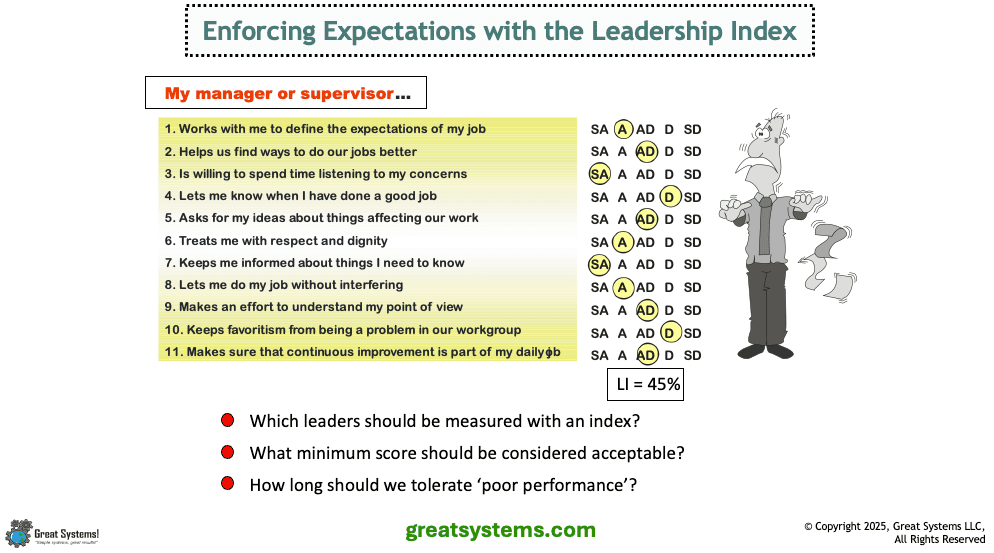How to Measure Leadership Behavior Effectiveness

How to Measure Leadership Behavior Effectiveness
How do you measure leadership behavior effectiveness? Measuring leadership behavior effectiveness with a Leadership Index helps align daily leader work habits with key team and site goals.
Its design mirrors one that Federal Express uses. This tool has been successfully applied in many organizations since that time. Plus, the current Gallup Q12 engagement survey closely mirrors the design of this Leadership Index.
Any organization, such as small businesses, health care, and education, can use the tool. Eleven statements make up the leadership index in the example shown. Leaders can adjust the mix of statements to align their leadership index statements with the strategic intent, mission, and values of the organization.
Its design mirrors one that Federal Express uses. This tool has been successfully applied in many organizations since that time. Plus, the current Gallup Q12 engagement survey closely mirrors the design of this Leadership Index.
Any organization, such as small businesses, health care, and education, can use the tool. Eleven statements make up the leadership index in the example shown. Leaders can adjust the mix of statements to align their leadership index statements with the strategic intent, mission, and values of the organization.
What is a Leadership Index?
The example Leadership Index consists of 11 statements. It is typically deployed as part of an employee attitude survey as a tool to measure leadership behavior effectiveness.
All of the people who report to a given leader, regardless of that leader's level in the organization, complete a survey. The survey usually occurs annually.
However, the use of quarterly 'index only' surveys is possible. The rest of this post explores how to calculate the resultant leadership index and use it to improve individual performance.
All of the people who report to a given leader, regardless of that leader's level in the organization, complete a survey. The survey usually occurs annually.
However, the use of quarterly 'index only' surveys is possible. The rest of this post explores how to calculate the resultant leadership index and use it to improve individual performance.
What types of beliefs, behaviors, and tasks should you expect your leaders to do in a lean thinking workplace? The lists shown on this slide were actually developed in a leadership team meeting in a company that really wanted to make the shift towards being a workplace that focused on performance excellence.
WATCH over 50 kaizen and workplace health improvement videos on my Great Systems YouTube channel.
WATCH over 50 kaizen and workplace health improvement videos on my Great Systems YouTube channel.
How do you calculate the Leadership Index?
In the above example, red letters indicate the response an employee provides when they complete the survey. The objective with this model is to obtain a SA (strongly agree) or A (agree) response for all eleven statements. To obtain such responses, the leader must act in a manner consistent with the expectation on a consistent basis.
In other words, an AD (sometimes agree / sometimes disagree) response is considered negative when the index is calculated. The raw data distinguishes this type of response from the D (disagree) or SD (strongly disagree) responses. However, the index does not.
In the example, 7 of the 11 statements have a positive (SA or A) response. This calculates into a leadership index of 64%. The FedEx model allows for a minimum index of 75.
This index hurdle requires that at least 75% of the workgroup share the same positive perception. Plus, it recognizes that there will be some people who select a negative response in spite of the best efforts that a leader might make.
What happens when a person in a formal leadership role scores lower than 75 on an annual or semi-annual survey? First, the leader goes on "probation." They must enter into a formal leadership improvement program.
On the next survey, if their score falls below the 75% level, the supervisor or manager lose their formal leadership role. However, they still remain an employee with the organization.
In other words, an AD (sometimes agree / sometimes disagree) response is considered negative when the index is calculated. The raw data distinguishes this type of response from the D (disagree) or SD (strongly disagree) responses. However, the index does not.
In the example, 7 of the 11 statements have a positive (SA or A) response. This calculates into a leadership index of 64%. The FedEx model allows for a minimum index of 75.
This index hurdle requires that at least 75% of the workgroup share the same positive perception. Plus, it recognizes that there will be some people who select a negative response in spite of the best efforts that a leader might make.
What happens when a person in a formal leadership role scores lower than 75 on an annual or semi-annual survey? First, the leader goes on "probation." They must enter into a formal leadership improvement program.
On the next survey, if their score falls below the 75% level, the supervisor or manager lose their formal leadership role. However, they still remain an employee with the organization.
What types of actions help improve Index scores?
In my experience, I have not found it necessary to actually demote a person who fails to obtain at least a minimum leadership index of 75. In at least 90% of the over 200 cases of my own use of this index, I found three things that help improve Index scores.
First, give them their personal survey feedback to review. Next, clarify task and behavior performance expectations. Third, help them create a clear, specific plan for improvement.
Finally, provide support as they attempt to make those improvements. For the remainder of the cases, the 'low score' leaders usually choose to take a different assignment on their own. They don't want to shift to the 'new' leadership expectations.
Additionally, leaders can modify this leadership behavior effectiveness measurement process. For example, they can make changes to either the minimum percentage and/or the length of the probationary period.
Keep three keys in mind. First, define clear consequences for improvement success and failure. Second, make a formal leadership improvement process available for use. Third, provide regular performance feedback between the formal surveys.
First, give them their personal survey feedback to review. Next, clarify task and behavior performance expectations. Third, help them create a clear, specific plan for improvement.
Finally, provide support as they attempt to make those improvements. For the remainder of the cases, the 'low score' leaders usually choose to take a different assignment on their own. They don't want to shift to the 'new' leadership expectations.
Additionally, leaders can modify this leadership behavior effectiveness measurement process. For example, they can make changes to either the minimum percentage and/or the length of the probationary period.
Keep three keys in mind. First, define clear consequences for improvement success and failure. Second, make a formal leadership improvement process available for use. Third, provide regular performance feedback between the formal surveys.
More Content with a Total Work Team Engagement Focus:
How can leaders customize the Leadership Index?
The leadership team can change the number of statements in the index, along with the statements themselves. Ideally, the organization's mission, vision, and value statements serve as sources for its Leadership Index statements.
Also, one can use the index to gauge the degree each leader supports major improvement initiatives (such as lean six sigma) or key organizational strategies.
All associates who report to the leader participate in the survey process. After the leader reviews the survey results, he or she reviews these results with their associates.
Then, each leader works with their people to develop an action plan for improvement. Headhunting (trying to find out WHO gave them a negative response) is discouraged, as is sharing scores without the consent of the leader. Often, the use an outside facilitator can assist with these feedback meetings.
Also, one can use the index to gauge the degree each leader supports major improvement initiatives (such as lean six sigma) or key organizational strategies.
All associates who report to the leader participate in the survey process. After the leader reviews the survey results, he or she reviews these results with their associates.
Then, each leader works with their people to develop an action plan for improvement. Headhunting (trying to find out WHO gave them a negative response) is discouraged, as is sharing scores without the consent of the leader. Often, the use an outside facilitator can assist with these feedback meetings.

LISTEN NOW to my "How to Measure Leadership Behavior Effectiveness" Real Life Work podcast

